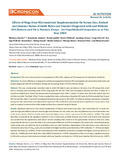| dc.description.abstract | Background: The role of micronutrients in management of HIV/AIDS, malaria and TB remains poorly understood worldwide. Objectives: To assess differences in mega dose nutritional management between HIV-seronegative and seropositive adult males and females diagnosed with HIV at Voluntary Testing and Counseling Centers (VCT) in Western Kenya. Methods: This was a randomized controlled study in which 90 subjects were recruited on the basis of an HIV-seropositive result from a voluntary and counseling center (VCT) using rapid HIV test kits. They were evaluated at baseline and every 4 weeks for 3 months to establish their clinical, biochemical and immunological status. After 12 weeks, 74 clients were still in the study, 9 were lost to follow-up while 7 had died. Of the 74 who completed the study, confirmation of baseline HIV status by ELIZA revealed that 63 were HIV-seropositive while 11 were HIV-seronegative despite losing spouses to HIV/AIDS. Correlations between parameters at baseline, during and after intervention were determined; Spearman’s Rho Coefficients indicating the level of significance. Group means were
used to compare continuous data while categorical data was compared using Chi-Square.
Results: Significant reductions in the clinical manifestation of disease were noted in the cohort after intervention for 12 weeks. Despite the large and different micronutrient dosages used between the two study arms, the only difference by arm of intervention was in the serum vitamin E level at 4 weeks which was much higher in arm 1 than it was in arm 2 of the study (p = 0.005). This might have been occasioned by the significant repletion of zinc in both arms, probably because use of citric acid in both arms improved zinc up-take from the supplements, food and/or reserves enabling other nutrients to be appropriately restored in both arms, these supporting the decision to pool the study arms and compare differences by HIV-seronegative and seropositive, notwithstanding the small sample sizes recruited but which nonetheless were our study limitation. Independent of the intervention arms, reduction of viral load by more than 0.5 log10 copies/ml correlated with higher baseline optical densities of HIV antibodies (P = 0.016) and higher
baseline viral loads (p = 0.0001). A lower optical density of HIV antibodies at baseline correlated with higher serum zinc levels at 12 weeks (p = 0.008) and a lower Body Mass Index (BMI) at baseline (p = 0.029). Independent of the arm of study, a significant increase in CD4 cells counts post intervention correlated with lower baseline viral loads (p = 0.010), lower baseline NK cell counts (p = 0.007) | en_US |

